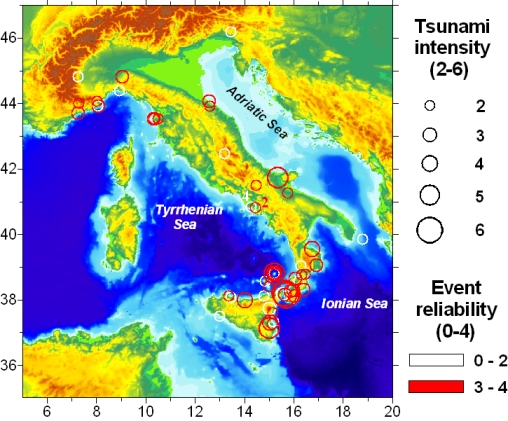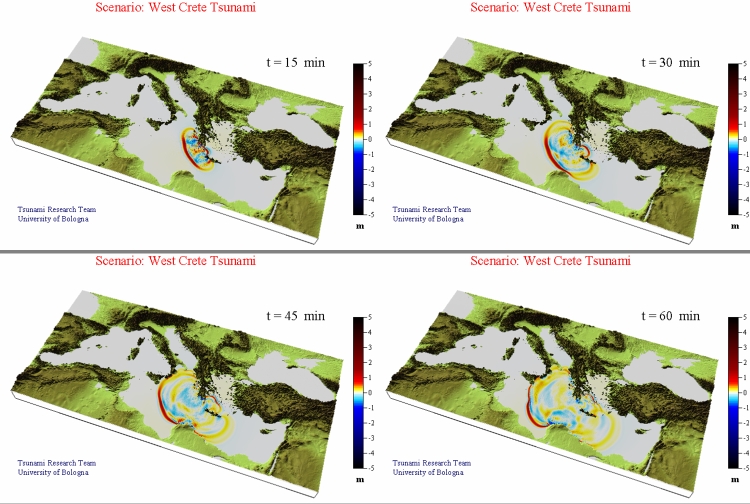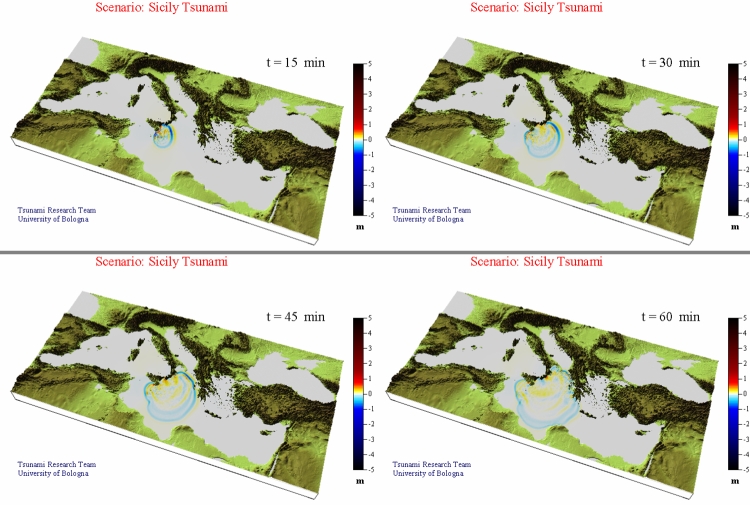The situation in the Mediterranean
 Fig. 1: Tsunamis in Italy from 79AD to today. The size of the circles is in proportion to the intensity of the tsunami; the colour is linked to the reliability of the events. (Credit: Tsunamis Research Team, Physics Dept - University of Bologna and National Institute of Geophysics and Volcanology (INGV) - Rome) |
The Sumatra tsunami attracted a sudden interest in a phenomenon which many of us had heard about but never really paid much attention to. However, it is wrong to think that a tsunami is a hazard only for faraway places like the Indian Ocean, the islands of the Pacific or areas particularly susceptible to earthquakes, such as Japan. There is in fact a risk of tsunami in the Mediterranean sea, as we can see from historic documents or simply by looking at the geological history of the basin. Big tsunamis have occurred here in the past, such as the one in Messina in 1908, or the one of 365 AD in Greece. The latest episode was the tsunami of Stromboli in 2002, fortunately without serious consequences as it happened in winter (30 December), when there were no crowds of tourists on the island. The waves were up to 10 metres high. As elsewhere, in the Mediterranean the cause of most tsunamis can be linked to seismic events, but we must not underestimate the effects of volcanic activity as far as Vesuvius, Etna and the Aeolian Islands are concerned, in particular Stromboli and Vulcano. The coasts most at risk are those of southern Italy, i.e. Apulia, Sicily and Calabria. Figure 1 shows a map of the tsunami sources in Italy from 79 AD to today (Italian Tsunami Catalogue, by Tinti, Maramai and Graziani, 2004).
On average, in the last four centuries Italy has seen 15 tsunamis every 100 years - a fact not to be taken lightly as far as the safety of the Italian coasts and its inhabitants is concerned.
The tsunami risk assessment can be studied by considering scenarios of future tsunamis, based obviously also on our knowledge of historical events. Figures 1 to 3 show the results of computer simulations prepared by the Tsunami Research Team at Bologna University. They refer to two distinct scenarios of tsunamis produced by violent underwater earthquakes. One scenario (Fig. 2) regards the eastern Mediterranean, with an earthquake west of Crete. Similar tsunamis occurred in 1303 and 365 AD. Fig. 3 shows the propagation of a tsunami in the central Mediterranean, caused by an earthquake off the coast of eastern Sicily, similar to the one of 1693. As we can see, the tsunamis propagate through the Mediterranean basin in a very short time. In fifteen minutes, a large area of the coast near the source of the tsunami is hit, and within an hour the tsunami has crossed the basin and arrived on the opposite coast.

Fig. 2: Scenario of a
possible tsunami in the Mediterranean, originating west of Crete. After 45 minutes the wave
has already hit the Italian coasts of Apulia, Calabria and eastern Sicily, with waves
up to several metres high.
Click on figure to see animated version in avi format.
(Credit:
Tsunami Research Team, Physics Dept, University of Bologna)

Fig. 3: Scenario of a
possible tsunami in the Mediterranean originating along the fault system of eastern Sicily.
After 45 minutes the wave has already reached the Greek coasts and hit a large part
of the Ionic coasts.
Click on figure to see animated version in avi format.
(Credit:
Tsunami Research Team, Physics Dept, University of Bologna)
The Mediterranean alert network
At the moment there is no tsunami alert network in the Mediterranean, or even
along the European coasts of the Atlantic or the Black Sea, even though historic
records show that tsunamis have hit these coastlines. The states of the
European-Mediterranean area have recognised that the lack of a network is not acceptable and have decided to install
an alarm system in the near future. For the moment an intergovernmental coordination
group has been set up at the IOC-UNESCO, called the ICG/NEAMTWS (Intergovernmental
Coordination Group for the establishment of the North East Atlantic, the Mediterranean
and connected seas Tsunami Warning System), which will operate under Italian presidency
for the first two years. Many problems will have to be solved. Unlike the networks in
the Pacific and the Indian Ocean, most of the source areas in the Mediterranean are very
near the coast and the main problem is being able to give the alarm within the first ten
minutes.